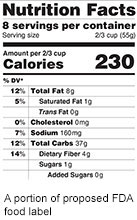
THURSDAY, Feb. 27, 2014 (HealthDay News) — The U.S. Food and Drug Administration formally proposed Thursday updating the “nutrition facts” labels on food products to better reflect Americans’ current eating habits and health concerns.
Among the highlights: the new labels would replace out-of-date serving sizes, highlight calorie content and draw attention to “added sugars.”
First Lady Michelle Obama said Thursday that America’s families will benefit from the proposed label makeover, which the FDA first unveiled last month.
“Our guiding principle here is very simple: that you as a parent and a consumer should be able to walk into your local grocery store, pick up an item off the shelf, and be able to tell whether it’s good for your family,” Obama said in an FDA news release. “So this is a big deal, and it’s going to make a big difference for families all across this country.”
Nutrition labeling was introduced two decades ago, and the FDA says the science and recommendations behind food labeling has changed since then. The proposed revisions take into account current knowledge of the link between diet and chronic diseases such as obesity, diabetes and heart disease.
“By revamping the Nutrition Facts label, FDA wants to make it easier than ever for consumers to make better informed food choices that will support a healthy diet,” Michael Taylor, the FDA’s deputy commissioner for foods and veterinary medicine, said in the news release.
Highlights of the proposal include:
- Calorie content and serving sizes would be featured more prominently to help address obesity, “one of the most important public health problems facing our country,” Taylor said. “What and how much people eat and drink has changed since the serving sizes were first put in place in 1994,” the agency said. Also, foods that can be consumed in one sitting would feature calorie and nutrition information for the whole package.
- Labels would need to show the amount of “added sugars” in a food product to help people distinguish between the natural sugars found in fruit and milk, for instance, and sugars added arbitrarily. Americans consume too much sugar and need to reduce their intake, according to 2010 Dietary Guidelines for Americans.
- Potassium and vitamin D — nutrients that help ward off high blood pressure and bone loss, respectively — would be listed on labels. Food makers could also include vitamins A and C, but they will no longer have to.
- “Daily values” for various nutrients such as salt, dietary fiber and vitamin D would be revised. These values are used to calculate the “Percent Daily Value” on the label, which helps consumers understand the nutrition information in the context of a total daily diet, the FDA said.
- “Total Fat,” “Saturated Fat” and “Trans Fat” would remain on labels, but not “Calories from Fat.” It’s now known the type of fat is more important than the amount.
Obesity experts welcomed the proposed update.
“Today is a big win for consumers,” said Dr. Glenna McCollum, president of the Academy of Nutrition and Dietetics and a registered dietitian. “The changes announced today are long overdue. There has been so much new research about consumers’ use of food labels, chronic diseases like obesity, diabetes and cardiovascular disease and how specific nutrients affect our health.”
“Meanwhile, the Nutrition Facts panel is more than 20 years old and does not reflect the current food environment or recent scientific research. Consumers want information they can use to make healthful choices,” she added.
Chris Ochner, an assistant professor of pediatrics at Mount Sinai Hospital in New York City, said the expected emphasis on calories and realistic serving sizes are sorely needed changes.
“Bar none, the number of calories is the most important thing an individual can pay attention to when it comes to their diet,” he said.
Americans have become increasingly health conscious, and listing realistic serving sizes will help them practice good nutrition, Ochner added. Currently, manufacturers can list nutrition facts for serving sizes much smaller than people typically consume, he said.
“For example, a 20-ounce bottle of soda contains 2.5 servings even though individuals typically consume them in one sitting. Until now, they would only be provided with nutrition information for less than half of what they typically consumed,” Ochner explained.
The addition of “added sugar” to food labels should help people realize just how much sugar they consume, he said. The recommended daily allowance of sugar for women is 6 teaspoons, he said, noting a 12-ounce can of regular soda contains 8 teaspoons of added sugar.
The FDA will accept public comment on the proposed revisions for 90 days. It is not known when the new labeling law would take effect, if approved.
More information
For more on healthy eating, visit the U.S. Department of Agriculture.
Copyright © 2025 HealthDay. All rights reserved.

